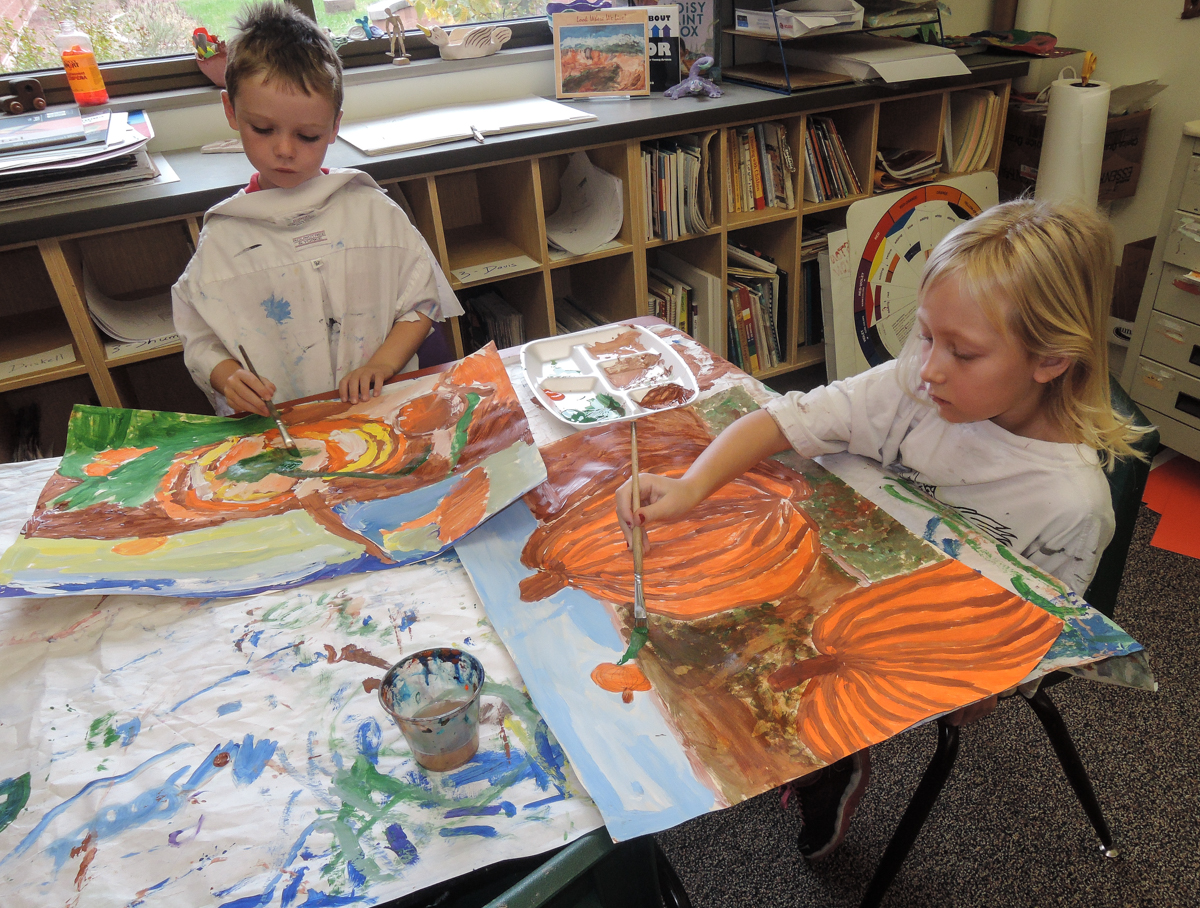1st Grade
1st Grade – is where children begin their path of reading. Most of the books they encounter are illustrated. Decoding the illustrations in a book is as important as decoding the words as both contain meaning. Many of our projects link to this basic idea.
Depth & the Pumpkin Patch
The study of depth begins in earnest in first grade. It’s a lesson that I add to incrementally with each grade. I find it one of the more important concepts to teach children. Our study begins with a slide show of various pieces of art showing depth, ending with the picture of a pumpkin patch moving from a large close pumpkin to those in the distance that appear smaller. “But why is this so?” I ask and demonstrate the artist’s trick. “But don’t believe me,” I say as we walk out to the playground to conduct the Shrink Your Partner experiment.
We have the kids line up as partners based on equal height. We learn to measure each other using our thumb and pointer finger. Partners back away from each other measuring. “You’re getting smaller!” they exclaim. This is fun. We then shrink their teacher and some soccer balls just to be sure that the concept is consistent.
Back in the classroom we perform an Art Coach led practice drawing.
Session #2 starts with looking at real pumpkins on the table. We see how to draw them and practice. We then commence to draw a pumpkin patch. Close pumpkins are made large and low on the paper. As they get further away they get smaller and higher on the paper. Students are encouraged to lay them at different angles. Some are then connected with vines and leaves that must mirror the size variation. The materials for this can vary. I’ve had students make realistic tempera paintings to wild Wizard-of-Oz-Pumpkin-of-a-Different-Color works. A nice twist is to outline the largest pumpkin with colored glue before painting (make sure it dries). This provides a nice texture that exaggerates the near/far illusion.
World’s Biggest Present
This brief, one session drawing brings the worlds of geometry and art together. We start with a simple square or rectangle, make it 3D and gradually add simple line details to make a scene where the box is wrapped and barely fitting in the room.
Opera
We have a first grade teacher who’s a music expert. Every year she leads two other teachers in the production of classroom operas. They each take a common folktale and re-write it as only 1st graders can. In art we make all the needed props. These include painted background scenes and a variety of other objects; 4-foot tall pizza pieces, a beanstalk that rises from a giant jellybean, a tree that drops magic fruit on cue and other items. The big lesson is in knowing that in addition to writing the opera, speaking and singing the parts, that they made the props, too
Shadow
With a spotlight and a variety of objects we first discover how shadows come to be and what their characteristics are. We then discuss behavior of Peter Pan’s shadow. Sometimes we draw them real and other times we really stretch the notion that shadows change shape.
Wild Child Flower
Over, under, around and through, let’s see what a wild child flower can do. With this mantra we extend the springtime study of plants. We first experience the effect of over and under lines and learn where to start and end them. To make the final drawing we draw a regular flower on a pretty straight stem. We then draw a wild seed. As it grows above ground it decides to not walk in a straight lunch line, but to go over, under and around the regular flower and itself. There are some moans when I show how to make the wild child stem go through something and then squeals of delight as the kids actually make it happen. The drawing ends when they design their own exotic wild flower.
















